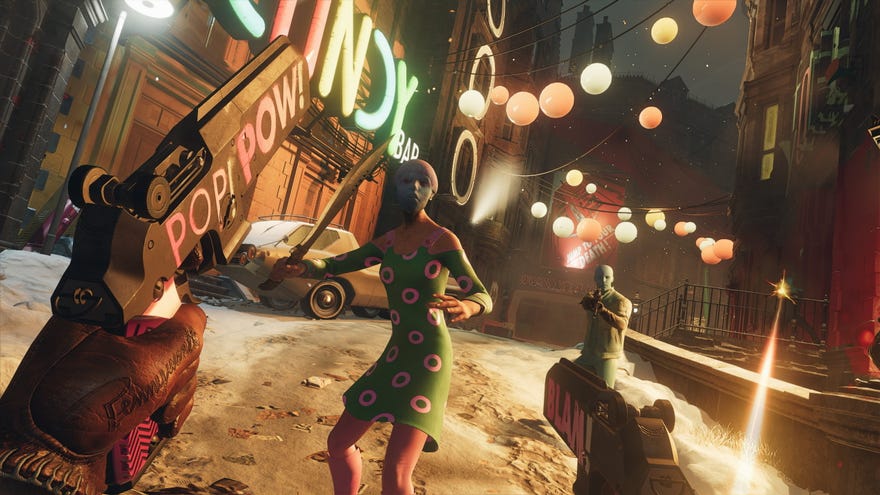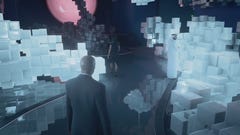How Arkane's multiversal Parisian pipedream eventually gave us Deathloop
Arkane founder Raphaël Colantonio on the game that got away
There’s an alternate world where Arkane made The Crossing, and it’s not necessarily a better one. Before Dishonored, the developer was looking down the wrong end of a bad publishing deal which, in the estimation of founder Raphaël Colantonio, would have ended in either The Crossing’s cancellation or a deeply underwhelming end product. In that timeline, there’s no telling whether the studio would even exist today.
Nevertheless, for fans of Arkane’s sophisticated and immersive first-person adventures, this lost project remains tantalisingly forbidden fruit: a foolhardy mashup of single and multiplayer in which teams of invading players would attack the protagonist of a solo campaign, against the backdrop of a multiversal Paris co-designed by Half-Life 2’s Viktor Antonov.
For years it was the source of Colantonio’s drive and inspiration, the idea he believed would be the making of his upstart French games company. And for several years afterwards, its abandonment was a painful wound he and the studio carried - one that only the eventual launch of Dishonored could help to heal.
At the time of The Crossing’s conception, Arkane was finishing up work on Dark Messiah Of Might And Magic, a swords-and-sorcery romp that forefronted close combat and physics play. For that project, Arkane had adopted Valve’s Source Engine, and identified a crossover in philosophy between its own immersive sims and Half-Life 2’s more focused, but no less detailed, simulation. “We were going a little more into those territories without betraying what we liked,” Colantonio says. “And hopefully we would do things that were a little more mass market.”
With The Crossing, Arkane intended to travel further down that path, building a full-on FPS in Valve’s engine. “Which was so shooter-oriented already,” Colantonio says. “And so that was a natural evolution. The tools dictate so much of what you do.” At the centre of this FPS would be an eight-hour campaign, like the one Call Of Duty had, and gunplay to match. But there the similarities with mainstream noughties shooters would end.
“It really started with a silly conversation,” Colantonio says. “‘Imagine someone was playing Half-Life 2, and you could choose to drop in and randomly incarnate the enemies.’ There was something beautiful about the idea itself. We didn’t know if it would be fun or possible. It became an obsession.”
After lending his inspired brutalist designs to City 17, Antonov had guided Arkane through Valve’s level design process during the making of Dark Messiah. Now he was returning from the US to France, where Colantonio and his team were based. He was quickly sold on the premise of The Crossing, and in particular the universe behind it. “Imagine if there were alternate realities that a group found a way to access and plunder,” was Colantonio's pitch at the time. “And there was this alternate dimension where the Templars had actually survived and created an entire world. They did not get eradicated by the Church, they were in power.”
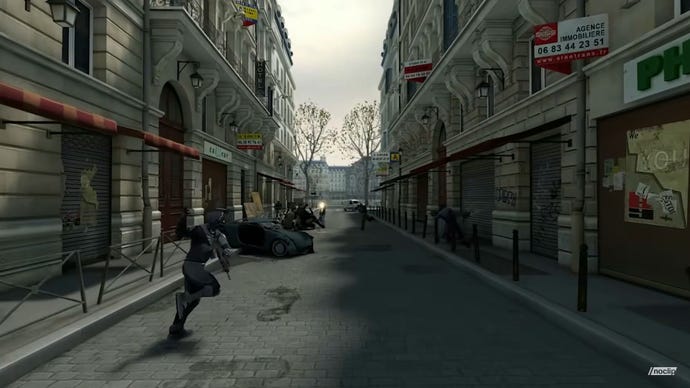
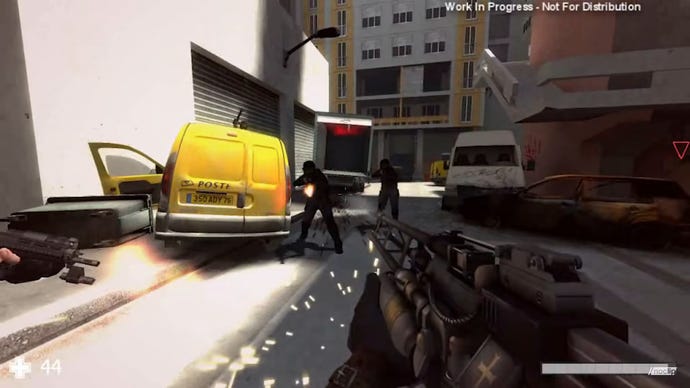
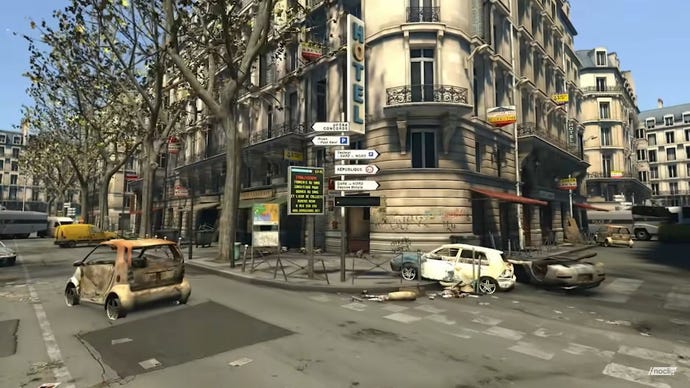
The Crossing of the title referred to a collision between the Earth we know, and this other Earth ruled by the Templars. “Somehow a portal has been created by scientists who are just going there to scavenge,” Colantonio says. “Then it creates a backlash, where the Templars come to our world with their own technology and cool looks and gadgets.” As a special forces operative called in after a Templar attack, you would gradually come to understand that this multiversal crisis was of our own making. And you would ultimately cross over from the Paris we know - modern, rundown, riven by strikes and revolutionary feeling - to a parallel city built by the Templars, taking on their cool looks and gadgets in the process.
With Antonov on board, working alongside Dishonored art director Sebastien Mitton, this latter Paris became a proto-Dunwall - a quasi-medieval dystopia defined by its gothic rooftops, smoking chimneys, elevated tramways, and sharp class divide. “Viktor trusted that we could make a cool game as far as mechanics [were concerned],” Colantonio says. “But what he really cared about was co-creating a very interesting world that would be beautiful and never seen before.”
Thief designer Randy Smith was tasked with plotting out the narrative - “a mind-bending time travel story that was loaded with a-ha! moments in which you realize you've seen this same situation or conflict from a different perspective.” He remembers the protagonist’s journey as a complicated figure-of-eight in which the player was constantly looping back on some prior part of their path.
“The beauty of it was that you never had to look for the action, because we would teleport you right before the player arrived.”
“Where those overlaps, those crossings, occurred - those were the places where you would enter a battle from a different approach and with a different objective than you had the first time you were there,” he says. “Technically speaking, this is a very economic game design - you can create one narrative quest path that services all players simultaneously, even though they're at different points of the story, and it conveniently feeds them into battles.”
Over time, Arkane boiled The Crossing down to a set of linear, story-driven levels - each with five choke points, where the protagonist would be waylaid by a mixture of NPCs and enemy players. “It was actually really smart at the end,” Colantonio says. “It took a lot of iterations. The principle was, you had a little cinematic at the beginning, which was maybe 30 seconds, during which the matchmaking would happen and people would drop in and choose their weapons.”
The solo player, called an Archon, would have access to a grappling hook and boomerang blade from the Templar realm. They had the benefit of mobility and a beefy health bar. But the enemy players, SWAT-esque soldiers dubbed Griefers, had numbers on their side. “They had their own gadgets, but different, and it was four versus one,” Colantonio says. “The beauty of it was that you never had to look for the action, because we would teleport you right before the player arrived.”
Typically, the Archon would get gunned down in their first round. But the Griefers would then repeat their winning strategy, “almost like an AI would do”, and the solo player would learn to counter it. “It would take the single player maybe four to six times to win a challenge, and that was a checkpoint for the next zone,” Colantonio says. “Then we would teleport all the players to the next area, so they would be rolling through the entire level this way. Every time we would show it to publishers it was so fun.”


The director remembers demoing The Crossing for a major publisher. “They were screaming in joy and laughing,” he says. “We had 15 people in that test room, rotating the positions and playing, and it was a super blast.” Once the play session was over, however, the smiles would quickly fade. Publishers would ask: what happens if the players are of different skill levels? “And that’s where the concept would break every time.”
Back in the early noughties, absurd though it seems today, only a handful of studios had mastered player matchmaking. One was Bungie. With “an army of like 100 people”, the Halo developer had figured out how to rank and combine players in satisfying fashion. Colantonio didn’t have 100 people. But he was wily, and had a talent for charming developers who, in terms of experience and reputation, were out of his league. He had set up a second studio in Austin - the home of his Deus Ex heroes at Ion Storm - and learned that Halo multiplayer genius Max Hoberman had quit Bungie to move nearby. “Me being me, I contacted him,” Colantonio says. “It sounded like maybe someone could save us.” Colantonio persuaded Hoberman to work on matchmaking for The Crossing one day a week: “Max would be in pitch meetings with us and look all serious and cool.” With him on board, Arkane was convinced a good deal was around the corner. But it never came.
“No matter what, it was always very hard to sell this game, because it was novel in so many ways, with a team that was not established yet,” Colantonio says. “We hadn’t done Dishonored. The budget was probably a tenth of Halo’s, but it was high for where we were in our career.” There were difficult marketing questions, too: “Are you going to sell it as a single-player game or a multiplayer game? Are you sure you’re gonna pull off the matchmaking thing you’re talking about? How is it going to be fun for the Griefers to be killed all the time by the superhero?”
In the end, as recounted in Noclip’s excellent documentary, Arkane was faced with accepting a bad deal from a publisher to make The Crossing on an inadequate budget, or walking away - and chose the latter. “They tortured us for nearly six months, into a deal that got worse and worse and worse,” Colantonio says. “There were so many constraints. The most enjoyable part of all this process was to tell them, ‘No.’ They really thought they had us. They were kind of evil, frankly, as businessmen.”
Arkane was sustained for a while by contract work on LMNO, a Steven Spielberg game that never came out, and a similarly cancelled Half-Life 2 expansion, codenamed Ravenholm. But the unhappy outcome of working on The Crossing had been bruising in the extreme. “It was my pet project,” Colantonio says. “I wanted it so much, and not having it when it didn’t work was one of my first big failures.” For his part as consultant, Smith was also disappointed The Crossing never came to be: “I think it would have been very fondly remembered and maybe even still played.”
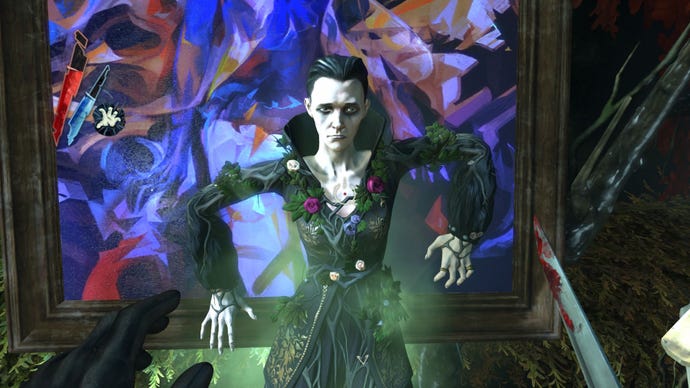
Arkane spent about a million dollars on the project, money it could ill afford at that time, and suffered a hit to morale. “The team was devastated,” Colantonio says. “I was devastated. I took it so to heart. I took it very personally because you can’t create something that needs so much energy and love half-assed or detached. You can’t be too Buddhist about it. The cost of that is that when it doesn’t work, you’re crushed.” Colantonio reckons it took him seven or eight years to get over the pain. Specifically, it took the release and reception of Arkane’s breakthrough hit. “We needed Dishonored to heal from The Crossing,” he says. “We needed that game and its success to feel good about ourselves again.”
But Colantonio was never tempted to exhume the project afterwards. “We talked about it with Bethesda,” he says. “For me that’s like an ex-girlfriend at this point, I’ve moved on. Coming back to it came with too many memories, too much pain.” And yet, almost every element of The Crossing has appeared somewhere in Arkane’s work since. Watch Noclip’s footage of the Archon in action, and you’ll recognise the possibilities for vertical navigation opened up by Dishonored’s Blink; the consequent surprise attacks and knife takedowns.
“One could say that, even though in the moment The Crossing felt like a painful failure, in the long run it was just a step towards a big breakthrough for Arkane,” Colantonio says. “Some of it was aesthetic, some of it was the mechanics themselves, and then there’s just the spirit of the team. We had worked together and trained with Viktor and Dishonored was ready to be made.” Later, Arkane co-developed Wolfenstein: Youngblood with MachineGames - Mitton finally lending his distinctive visual style to a dystopian Paris. Swap the Nazis for Templars and you’ll recognise The Crossing. “I remember thinking the same,” Colantonio says. “It’s the same art director, so no surprise.”
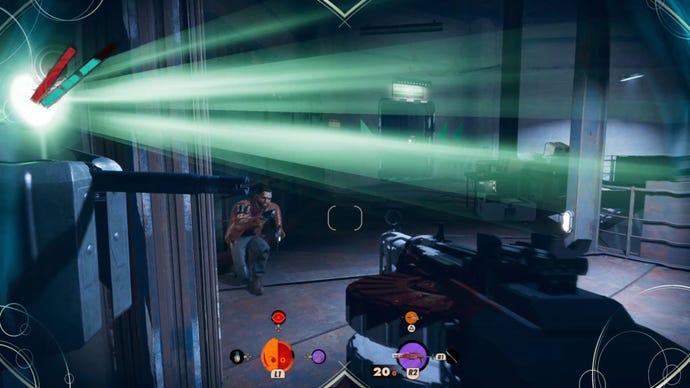
And then, finally, there’s Deathloop, which entered development around a year before Colantonio left Arkane in 2017. It came together under the leadership of director Dinga Bakaba, level design guru Christophe Carrier and art director Mitton. “They saw it as an opportunity to re-explore some of the concept of The Crossing,” Colantonio says. “To all of us, frankly, The Crossing stayed as this kind of unfinished business.” Once again, Arkane was making a campaign FPS that could be interrupted by player invasions.
Colantonio was supportive, but a little afraid. Bethesda wanted a little idea to tide Arkane over until its next Dishonored-sized project, and not for the first time, he wondered how the studio would pull off such a big premise with a small budget. In the end, however, Bethesda gave Deathloop its backing as a full-scale release, and it launched to effusive critical acclaim. Though very different to The Crossing - made without Colantonio’s direct involvement and rooted in a very modern form of roguelike thinking - you can see its success as a form of vindication.
For many years, playing The Crossing’s prototype was a rite of passage for new employees joining Arkane. Today, Colantonio would like to see that build released to the public. “It would be cumbersome to make work,” he says. “It was not ready for market. But someone would figure it out. I still hope that Arkane will convince Microsoft to do it, because it was a fun game, it was not vapourware.”
